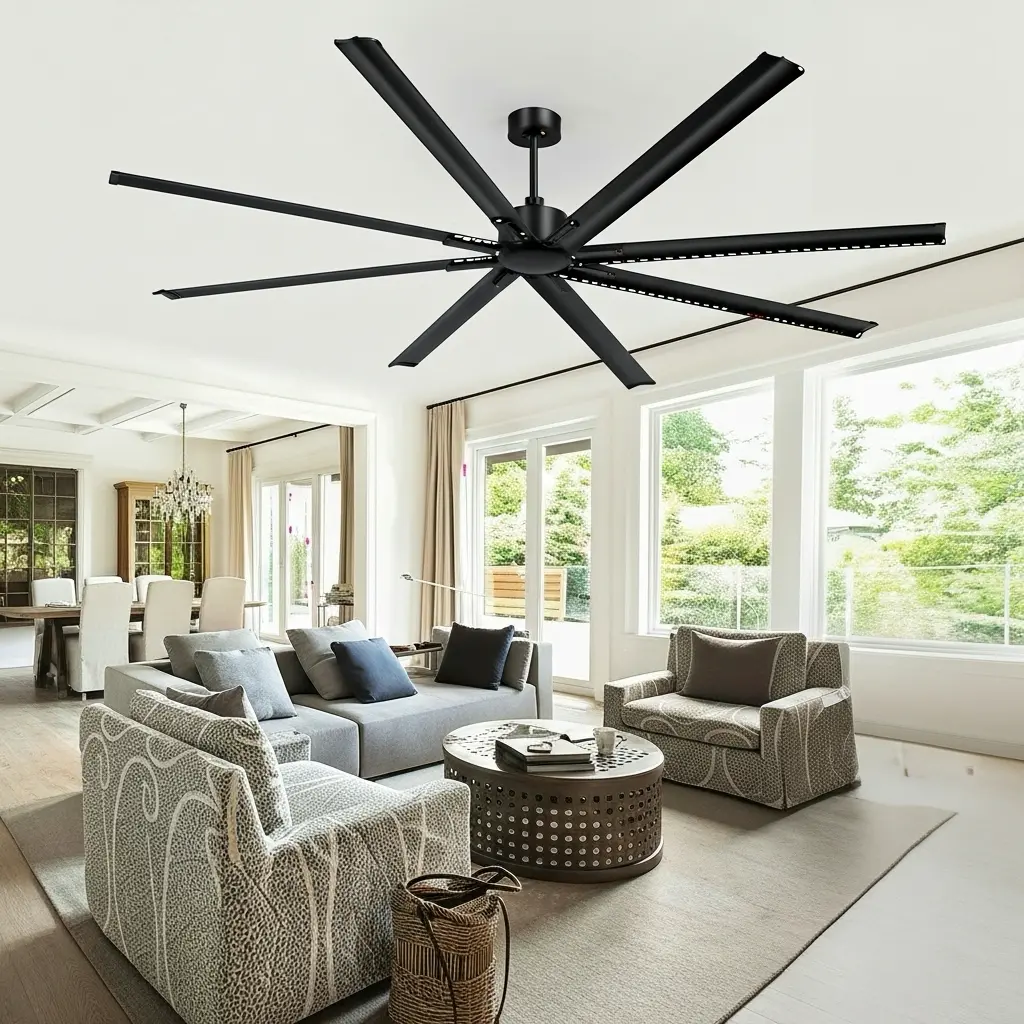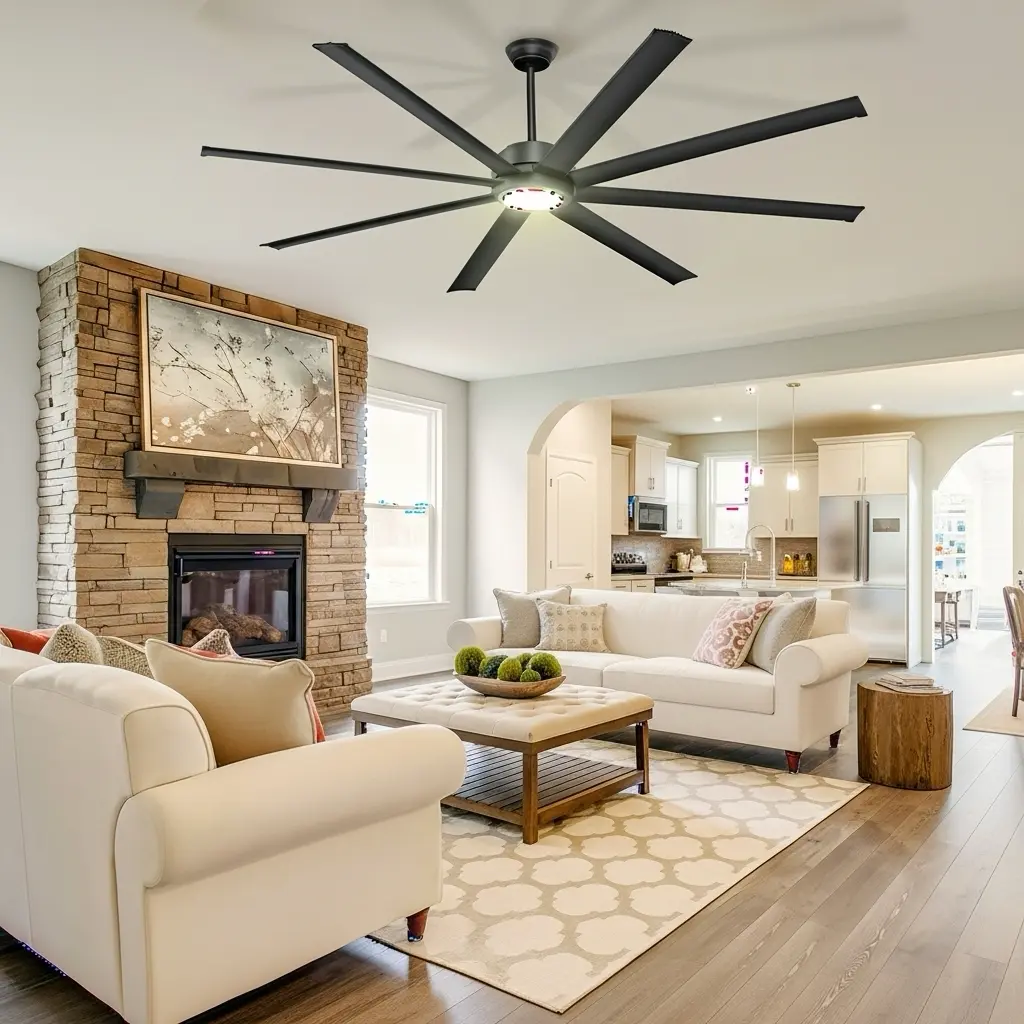Learn everything about large industrial ceiling fans how they work, how to size them correctly, top models compared, and how they cut energy costs in warehouses, gyms, and factories.
Large industrial ceiling fans are no longer just spinning blades they’re precision-engineered airflow systems that balance performance, durability, and energy efficiency. These giants of the ceiling deliver steady, powerful circulation across tens of thousands of square feet while consuming surprisingly little electricity. In 2025, with energy costs and workplace comfort both under scrutiny, large-diameter fans have become an essential investment for modern facilities across North America.
Table of Contents
What Defines a Large Industrial Ceiling Fan?
Fans in this category generally exceed 7 feet (2.1 meters) in diameter and can reach up to 30 feet. They’re designed to move high volumes of air at low rotational speeds (typically 40–70 RPM). This slow movement minimizes turbulence while maintaining consistent airflow, making them ideal for warehouses, manufacturing facilities, gyms, and agricultural structures.
According to MacroAir’s industrial buying guide, large ceiling fans cover up to 20,000–25,000 sq ft per unit equivalent to replacing 20–30 smaller high-speed fans with one efficient system.

The Science of Airflow: CFM, Torque, and Tip Speed Ratio
The performance of large fans is measured in CFM (Cubic Feet per Minute), representing the total air moved per minute. This depends on three key variables:
- Blade Diameter (D): Larger diameters exponentially increase air displacement area.
- Rotational Speed (N): Slower speeds reduce turbulence and noise but maintain consistent flow.
- Blade Pitch and Torque: A 10–14° blade pitch ensures optimal lift and distribution.
The airflow volume can be approximated using the simplified relation:
CFM = k × D² × N
Where k is a proportional constant dependent on blade geometry and air density. For example, doubling the diameter quadruples the effective airflow at the same speed—highlighting why large fans outperform multiple smaller ones.
Figure 1 – Placeholder for Airflow Diagram: Depict how airflow radiates horizontally from the fan hub, forming a “floor jet” pattern that stabilizes temperatures across the room.
Energy Efficiency: The Tip Speed Advantage
Tip speed—the velocity of the blade’s outer edge—is critical for balancing power and noise. The ideal tip speed range for large fans is between 700–1,200 ft/min. Above that, drag increases exponentially, reducing efficiency and creating noise. Manufacturers fine-tune this balance through blade design and material selection.
Top Large Industrial Ceiling Fan Models (2025 Comparison)
| Brand & Model | Diameter (ft) | Airflow (CFM) | Motor Type | Power Draw (kW) | Efficiency (CFM/W) | Noise (dB) |
|---|---|---|---|---|---|---|
| Big Ass Fans – Powerfoil X4 | 24 | 400,000 | Direct Drive PMSM | 0.78 | 513 | 52 |
| MacroAir – AirVolution D | 20 | 310,000 | Direct Drive | 0.65 | 477 | 50 |
| Hunter Industrial – Titan | 24 | 380,000 | EC Motor | 0.72 | 528 | 53 |
| Marut Air – Elite 18 | 18 | 210,000 | EC Motor | 0.50 | 420 | 54 |
Table 1 – Comparison of large industrial ceiling fans based on airflow and power efficiency data.

Installation and Safety Engineering
Large industrial fans must meet CSA C22.2 and UL 507 standards for mechanical integrity and electrical safety. Installation requires structural analysis to confirm beam load capacity. OSHA recommends a 10 ft minimum clearance from the floor and 3 ft from structural obstructions.
- Use beam clamps and graded fasteners rated for at least 150% of fan weight.
- Ensure balanced torque distribution—uneven bolt torque causes vibration.
- Connect through a dedicated circuit breaker rated at 15A minimum.
- Install safety cables to prevent drop hazards, especially in seismic zones (per ASCE 7-22).
Performance vs. Cost Analysis
Initial installation of large fans ranges from $4,000–$12,000 per unit. However, annual savings on HVAC energy can reach $1,000–$2,500 per fan. The payback period typically falls between 2 and 3 years, depending on operating hours and local electricity rates.
Figure 2 – Placeholder for ROI Chart: Depict cost recovery curve comparing initial investment vs. 36-month cumulative savings (energy and HVAC efficiency).
Noise and Comfort Comparison
| Model | Noise (dB) | Perceived Environment | Recommended Space |
|---|---|---|---|
| Big Ass Fans X4 | 52 | Quiet – Conversation-level | Warehouses, distribution centers |
| Hunter Titan | 53 | Low mechanical hum | Gyms, production floors |
| MacroAir D | 50 | Library-level quiet | Auditoriums, retail halls |
Maintenance and Longevity
- Inspection: Every 12 months, check all bolts and bearings for wear or looseness.
- Cleaning: Dust accumulation can reduce efficiency by up to 10 %—wipe blades quarterly.
- Lubrication: Direct-drive motors require none; belt-driven units need lubrication annually.
- Expected Lifespan: 15–25 years for direct-drive models with minimal maintenance.
Environmental and Economic Benefits
Each large fan can offset up to 3–5 metric tons of CO₂ annually by reducing HVAC energy use. Over a decade, this equals removing 40–50 vehicles’ worth of emissions. These fans also contribute to LEED certification credits (Energy & Atmosphere EA1.1).
Canadian and Quebec Climate Applications
In colder regions like Quebec, Manitoba, and Alberta, industrial buildings suffer from severe thermal stratification—warm air trapped at the ceiling while workers remain cold below. Large fans break this layer, redistributing heat evenly and cutting heating costs by 25%. Paired with smart thermostats, destratification systems can achieve ROI in under two years.
FAQ About Large Industrial Ceiling Fans
- Q: How many fans does my building need?
A: One 24 ft fan covers up to 20,000–25,000 sq ft effectively; for irregular layouts, use two smaller units spaced evenly. - Q: Can I use them outdoors?
A: Yes, provided they’re rated for damp or wet environments per UL 507. - Q: Are they noisy?

